Plant Profiles
Click on the first letter of the common name of the plant you wish more information about.
A | B | C | D | E | F | G | H | I | J | K | L | M | N | O | P | Q | R | S | T | U | V | W | X | Y | Z
X
Y
Z
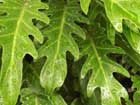
Xanadu Philodendron
Scientific Name: Philodendron x 'Xanadu'
Growth Habit: A rounded shrub, with evergreen deeply cut leaves, growing to 3 feet tall.
Light: Tolerates full sun; grows best in filtered-sun to shady locations.
Feedings: Apply a balanced fertilizer once monthly in March, May and September.
Water Needs: Survives short periods of drought; grows best with weekly waterings.
Ease of Culture: Easy.
Propagation: Commercially started through tissue culture; can be rooted from cuttings.
Hardiness: Tender; plants in shade normally survive cold with a cover.
Major Problems: Plantings are mostly pest-free. Grow in well-drained soils and avoid keeping wet to avoid root-rot problems.
Pruning: Plantings grow slowly but steadily and may need pruning to avoid competition with nearby ornamentals. Pruning is normally needed after severe cold to remove declining foliage.
Uses: An excellent plant for shady gardens, foundation plantings and borders. Also can be grown in containers to use indoors or on the patio.
Florida Native: No; a hybrid.

Yarrow
Scientific Name: Achillea millefolium
Growth Habit: A clump-forming evergreen perennial forming a base of arching foliage with flowering shoots growing to 2 feet tall. The leaves are gray-green, fernlike and deeply divided, growing to 6 inches long and 1 inch wide.
Light: Plant in full sun to lightly shaded locations.
Feedings: Apply a general garden fertilizer once monthly in March and June.
Water Needs: Drought tolerant, surviving for weeks without water; grows and flowers best with weekly waterings.
Ease of Culture: Easy.
Propagation: Start plants from seed or by division of older clumps.
Hardiness: Hardy.
Major Problems: Plant in well-drained soils to avoid root-rot problems. Foliage may be affected by chewing insects, but controls seldom are needed.
Pruning: Trim declining flower heads to encourage a continuous bloom. Remove flowering shoots when the stems begin to brown. Edge beds and planting sites as needed to prevent yarrow shoots from invading nearby plantings.
Uses: An attractive flower, blooming March through May for the perennial flower bed and rock garden. Flowers open white, pink and red in clusters at the tops of tall shoots. The stalks of blossoms can be cut for bouquets or saved for dry flower arrangements. Plants also may be grown in containers for porch, balcony or patio displays.
Florida Native: No; native to Europe and western Asia.
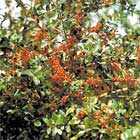
Yaupon Holly
Scientific Name: Ilex vomitoria
Growth Habit: An evergreen upright to rounded small tree or large shrub growing to 20 feet tall. The plants are twiggy and have small spine-free leaves.
Light: Plant in full-sun to lightly shaded locations.
Feedings: Feed lightly in March and June for the first three years. Thereafter adequate nutrients are obtained from decomposing mulches plus nearby lawn and shrub feedings.
Water Needs: Drought tolerant; can usually exist with the moisture from seasonal rains.
Ease of Culture: Easy.
Propagation: Start plants from seeds or cuttings.
Hardiness: Hardy.
Major Problems: Light leaf loss may be noted because of fungal leaf spots and leaf minor insect damage. Controls seldom are needed.
Pruning: Yaupon hollies produce shoots from the base and the roots that compete with the central trunk. Prune the shoots to the ground as needed to keep an attractive tree.
Uses: Often planted as small accent trees near patios and walkways or can be added as a backdrop for flower gardens and shrub plantings. Female selections produce shiny red berries during fall and winter. The fruits are a favorite food for wildlife. A weeping form known as Pendula is available.
Florida Native: Yes.
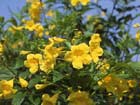
Yellow Elder
Scientific Name: Tecoma stans
Growth Habit: An evergreen, rounded, large shrub to small tree with numerous branches growing to 15 feet tall and wide. The bright-green compound leaves grow to 10 inches long and half as wide with up to 13 leaflets.
Light: Plant in full-sun locations.
Feedings: Apply a general garden fertilizer once monthly in March and June if needed to encourage growth.
Water Needs: Drought tolerant; can exist with seasonal rains.
Ease of Culture: Easy.
Propagation: Start plants from seeds or cuttings.
Hardiness: Tender; damaged by severe freezes but can grow back from buds near the ground.
Major Problems: Chewing and scale insects occasionally might feed on the foliage and stems but seldom need control.
Pruning: The trees have a free branching habit and need trimming to keep a central trunk. Remove limbs of young trees competing with the central leader. Plants with multiple trunks can be grown to produce large shrubs. Remove out-of-bounds limbs as needed to keep the rounded growth habit. Also, remove any cold-damaged limbs during February just before growth.
Uses: An attractive accent plant that opens clusters of bell-shaped yellow blossoms March through December. Plant near the patio, near entrances and along walkways for a burst of color. Plants also can be grown in containers to set on patios or decks.
Florida Native: No; native to the Caribbean region.
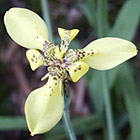
Yellow Walking Iris
Scientific Name: Trimezia martinicensis
Growth Habit: An upright evergreen, perennial, bulblike plant with foliage originating from near the soil line. This is an iris relative with swordlike foliage that grows to 30 inches tall and 11/2 inches wide.
Light: Grows in full sun to shade.
Feedings: Apply a general garden fertilizer once monthly in March, June and September.
Water Needs: Drought tolerant; can exist with seasonal rains, but grows best with weekly waterings.
Ease of Culture: Easy.
Propagation: Start plants by division of clumps and removal of "plantlets" that root from the ends of flowering stems.
Hardiness: Medium; damaged by freezes but usually grows back from buds near the ground.
Major Problems: Chewing insects occasionally may feed on the foliage but seldom need control.
Pruning: Remove cold-damaged leaves at the end of February before growth starts. Plants are vigorous and often need trimming to remove excessive plants and keep the foliage in bounds.
Uses: Plant in clusters to enjoy the attractive yellow irislike blossoms with brown barred markings April through November. Blossoms last only a day, but the long arching, flowering stems have many buds and leaves that eventually root as the shoots bend down and touch the ground. Add to perennial gardens, shady sites and along walkways. Plants also may be grown in containers for porch and patio displays.
Florida Native: No; native to tropical America, including Brazil, Mexico and Jamaica.
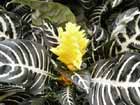
Zebra Plant
Scientific Name: Aphelandra squarrosa
Growth Habit: An upright evergreen perennial growing to 18 inches tall and 12 inches wide. The leaves are dark green with white banding along the veins; they grow to 8 inches long and half as wide.
Light: Grow in a bright location but out of direct sun.
Feedings: Apply a 20-20-20 or similar fertilizer every other week March through November, none during the winter months.
Water Needs: Keep moist by watering when the surface soil begins to dry March through December; allow the surface soil to dry between waterings during the winter.
Ease of Culture: Easy.
Propagation: Start plants from cuttings during warmer spring through early summer months.
Hardiness: Tender; protect from temperatures below 40 degrees.
Major Problems: Aphids, mealybugs and scale insects are common pests. Control as needed with a soap or oil spray, following label instructions.
Pruning: Remove browning inflorescences throughout the growing season. Also use this time to trim lanky shoots and reshape the plants to encourage branching.
Uses: Display in the home or on the patio in containers to enjoy the exotic and tropical look of zebra plants. The variegated foliage creates year-round interest, and bright yellow inflorescences form at the tops of shoots April through December. The small flowers are open for only a few days, but the colorful yellow bracts remain attractive for weeks. Plants can be added to in-ground tropical gardens, but they are usually damaged by the cold weather.
Florida Native: No; native to Brazil.
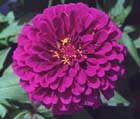
Zinnia
Scientific Name: Zinnia elegans
Growth Habit: An upright to rounded annual plant with broad, fuzzy, light green leaves produced on plants growing to 4 feet tall and wide.
Light: Plant in full-sun locations.
Feedings: Apply a general garden fertilizer once every 3 to 4 weeks to in-ground plantings, weekly to plants in containers.
Water Needs: Prefers a moist soil. In-ground plantings grow best with weekly waterings; check container plantings for daily needs.
Ease of Culture: Easy.
Propagation: Start new plants with seed 6 to 8 weeks before they are needed in the garden.
Hardiness: Tender.
Major Problems: Zinnias are affected by fungal leaf spots and powdery mildew. Newer varieties appear to have some resistance to these diseases, making plantings possible even during the warmer, damp summer. Also check for chewing insects and handpick from the plants as needed.
Pruning: Remove the declining blooms to produce new flowers. Also cut bouquets to encourage flowers and reshape the plants as needed. Trim declining plants from the garden as they complete their life cycles.
Uses: Zinnias are planted March through October. Varieties are available in a rainbow of colors, and blossoms are up to 6 inches in diameter. The blooms have a mild fragrance and attract butterflies. Plant clusters in annual flower beds, along walkways and in container gardens. Use lower growing varieties as borders and taller types as backdrops for other flowers.
Florida Native: No; native to Mexico.

